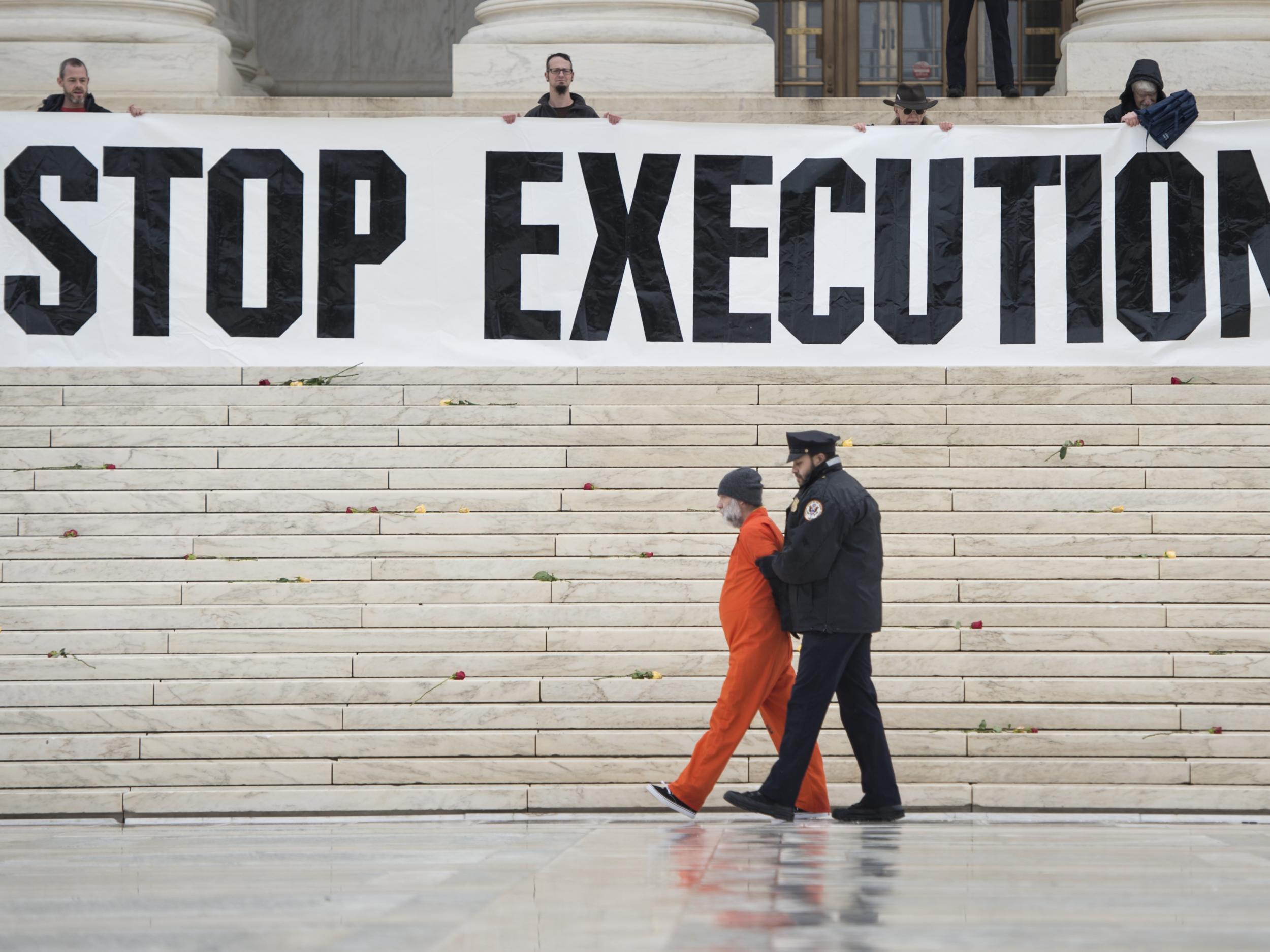America to trial using nitrogen gas as method of execution
Lethal injection promised to be more humane than the electric chair and gas chamber – but failed, with many prisoners suffering extreme agony for hours. Now some states are trialling nitrogen inhalation

Your support helps us to tell the story
From reproductive rights to climate change to Big Tech, The Independent is on the ground when the story is developing. Whether it's investigating the financials of Elon Musk's pro-Trump PAC or producing our latest documentary, 'The A Word', which shines a light on the American women fighting for reproductive rights, we know how important it is to parse out the facts from the messaging.
At such a critical moment in US history, we need reporters on the ground. Your donation allows us to keep sending journalists to speak to both sides of the story.
The Independent is trusted by Americans across the entire political spectrum. And unlike many other quality news outlets, we choose not to lock Americans out of our reporting and analysis with paywalls. We believe quality journalism should be available to everyone, paid for by those who can afford it.
Your support makes all the difference.Hamstrung by troubles with lethal injection – gruesomely botched attempts, legal battles and growing difficulty obtaining the drugs – states in America are looking for alternative ways to carry out the death penalty. High on the list for some is a method that has never been used before: inhaling nitrogen gas.
Oklahoma, Alabama and Mississippi have authorised nitrogen for executions and are developing protocols to use it, which represents a leap into the unknown. There is no scientific data on executing people with nitrogen, leading some experts to question whether states, in trying to solve old problems, may create new ones.
“If and when states begin carrying out executions with nitrogen, it will amount to the same type of experimentation we see in the different variations of lethal injection,” said Jen Moreno, a lawyer who is an expert on lethal injection at the Berkeley Law Death Penalty Clinic.
With some 2,750 inmates on death row in 31 states and in federal and military prisons, any jurisdiction that tries something new will be scrutinised as a test lab.
The push for change comes because lethal injection, introduced 40 years ago as more efficient and humane than the electric chair or gas chamber, has not met that promise. Indeed, it has sometimes resulted in spectacles that rival the ones it was meant to avert.
One pitfall is that execution teams must find a vein to infuse, a process that can be excruciating. In February, an Alabama execution team gave up after trying for more than two hours on an inmate whose blood vessels had been damaged by chemotherapy and drug abuse. His lawyer accused the team of opening an artery and puncturing the prisoner’s bladder. The state later said it would not try again to execute him.

Lethal injection also involves drugs that, if given incorrectly, can result in suffering. One is a paralysing agent, and the other stops the heart. The paralysing drug was included in the original plan for lethal injection partly to make the process look peaceful and less disturbing to witnesses, by preventing the prisoner from thrashing around.
Both it and the heart-stopping drug are supposed to be given after a powerful sedative has rendered the person unconscious, but if the sedative does not work properly, the other two drugs can cause significant pain.
Barbiturates were originally used for sedation, but manufacturers began refusing to sell them for executions. So states tried substituting other drugs. Some were ineffective and left prisoners moaning in what appeared to be prolonged agony.
Nebraska and Nevada hope to soon start using the opioid fentanyl as a sedative. Illegal use has made it a scourge of national death statistics, but medically it is an important painkiller and anaesthetic.
Defence lawyers in Nebraska have argued that fentanyl comes under a federal law that limits its distribution to lifesaving purposes, and that it is therefore against the law for a prison clinic to distribute it for an execution. A trial seeking information about the source of the fentanyl is scheduled for 14 May.
In March, Oklahoma’s attorney general, Mike Hunter, said that using nitrogen was “the safest, the best and the most effective method available”.
There is scant scientific data to back up that statement. What little is known about human death by nitrogen comes from industrial and medical accidents and its use in suicide. In accidents, when people have been exposed to high levels of nitrogen and little air in an enclosed space, they have died quickly. In some cases co-workers who rushed in to rescue them also collapsed and died.

Nitrogen itself is not poisonous, but someone who inhales it, with no air, will pass out quickly, probably in less than a minute, and die soon after – from lack of oxygen. The same is true of other physiologically inert gases, including helium and argon, which kill only by replacing oxygen.
A report from the US Chemical Safety and Hazard Investigation Board said that breathing “an oxygen-deficient atmosphere” can knock a person unconscious after just one or two breaths, and that “the exposed person has no warning and cannot sense that the oxygen level is too low.”
(Although nitrogen itself would be novel, gas chambers have existed as a US execution method since the 1920s. The last case was in 1999, when Arizona used clouds of hydrogen cyanide to execute an inmate. Coughing and hacking, he took 18 minutes to die.)
Death from nitrogen is thought to be painless. It should prevent the condition that causes feelings of suffocation: the buildup of carbon dioxide from not being able to exhale. Humans are highly sensitive to carbon dioxide – too much brings on the panicky feeling of not being able to breathe.
Somewhat surprisingly, the lack of oxygen does not trigger that same reflex. Someone breathing pure nitrogen can still exhale carbon dioxide and therefore should not have the sensation of smothering.
Before passing out, a person may feel lightheaded, dizzy or maybe even a bit euphoric, and vision may dim.
Dr Charles D Blanke, who has studied data on physician-assisted dying, said it was not at all clear that nitrogen inhalation would bring a peaceful death. Blanke, a medical oncologist and professor at Oregon Health and Science University, said he had consulted colleagues in pulmonary medicine and anaesthesiology, and they had concerns that carbon dioxide actually could build up and cause feelings of suffocation.

Nitrogen is not used in states where medically assisted dying is legal; those patients, who are terminally ill, usually drink a huge dose of barbiturates.
Veterinary experts generally do not recommend nitrogen or other inert gases for euthanising mammals. Responses to the gas vary according to species, and in its 2013 guidelines, the American Veterinary Medical Association said: “Current evidence indicates this method is unacceptable because animals may experience distressing side effects before loss of consciousness.”
Unlike lethal injection, the use of nitrogen would not require that the execution team dig around for a vein. An anaesthesiologist, who requested anonymity because medical societies bar members from participating in executions or providing information to encourage them, said that nitrogen inhalation was less cruel than lethal injection. And since it presumably would involve no paralytic agent, witnesses would be able to see whether the person seemed to be suffering, he said.
Seizures might occur from inhaling nitrogen, he said. But if the technique appears to go smoothly, he predicted that other states would quickly adopt it.
In fact, according to state documents, in May 2016 an Arizona company sent a sales-pitch letter for nitrogen gas executions to Nebraska officials. Among the standout features of its Euthypoxia Chamber: it “produces calm and sedation followed by inebriation and euphoria”; it “requires no medical expertise”; and it guarantees “the demise of any mammalian life in four minutes”.
In passing along the letter to another official, a state corrections department executive hand-wrote: “I’m not intending to respond – just thought it was an odd correspondence.”
Moreno, of the Berkeley Law Death Penalty Clinic, said that implementing nitrogen gas is not as simple as states suggest. There are different grades of nitrogen, including medical and industrial with commensurate purities and regulations.
Observers of the execution would need protection. Officials would have to figure out how to safely clear nitrogen from the room before a physician could declare death and the staff could remove the body.

The Final Exit Network, a volunteer organisation that supports the rights of people with terminal illness or intractable suffering to end their lives, considers nitrogen inhalation a reasonable method, and directs people to information about it. The technique involves putting a plastic bag over one’s head and pumping in nitrogen.
Janis Landis, president of the network, said: “The science behind inert gases is quite well settled. Any inert gas one can breathe in, in place of oxygen. You don’t have air hunger. You can keep breathing. You pass out and you die.”
She said that in the past, many people had used helium to end their lives, from tanks they purchased at party-supply stores that stock them to inflate balloons.
But some suppliers, realising their product was being used for suicide, began mixing in air, making the helium less effective, so nitrogen became the preferred choice.
Landis said: “People opposed to the death penalty, scratching their heads about how this could work, I think they’re mixing up their views about whether this should be done versus whether it can be done.”
Experts on state-sanctioned execution methods suggest that the search for a palatable means of carrying out death sentences is itself uniquely American. Aside from the United States, the relatively few countries who execute prisoners typically do so by hanging, beheading or firing squad – methods that most Americans find repugnant.
Robert Dunham, executive director of the Death Penalty Information Centre, said that such a reaction exemplifies the collision between two contradictory traits that streak through the national identity.
“One is a tradition of tenderness, with us being the safeguard of human dignity and decency,” he said. “The other is a culture of violence. And when you’re concerned about human rights and dignity, that carries an aversion to gruesome killings by the state. But the death penalty is inherently violent – so those traditions now are really at loggerheads.”
© The New York Times
Join our commenting forum
Join thought-provoking conversations, follow other Independent readers and see their replies
Comments